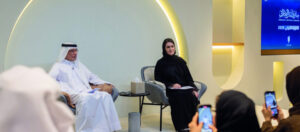Each week in this new series we analyse a piece of art that is on show in the UAE. Here we look at the remarkable ‘Fountain of Light’
When Louvre Abu Dhabi opened last November, Ai Weiwei’s dazzling Fountain of Light, a twisting steel structure containing 32,400 glass crystals, quickly became a social media star. Placed in the last gallery of the permanent collection, the sculpture caps the journey through the museum. Above it, a panel has been removed in the ceiling, as if the structure itself winds outwards towards the starry dome above.
Many visitors assumed the work, with its healthy dose of bling, was commissioned expressly for Abu Dhabi. While this version of the artwork was made and adapted for Louvre Abu Dhabi, Ai first made a similar version in 2007 for Liverpool – a city rather less known for its sparkling glamour. It was installed in the Victorian-era Albert Dock – site of Tate Liverpool, which commissioned the work. The reflection of the glass pendants danced on the surface, an aqueous element that appeared in its title, Working Progress (Fountain of Light).
But the real story doesn’t even start there – Fountain of Light is based on a Russian work from nearly a century ago. Ai’s sculpture reimagines an unbuilt structure from 1919, Vladimir Tatlin’s Monument to the Third International. Tatlin proposed a twisting building for the headquarters of the Comintern, the international organisation that aimed to bring about world communism.
Organised around an angled steel girder that would have climbed to 400 metres, the Monument would have been the apex of technological mastery and the embodiment of communism’s soaring ambitions. The building would have had four glass sections that would have each revolved at different speeds: the main structure would complete its turn in a year, for example, and the radio station at the top would revolve every hour.
Tatlin’s Monument became a touchstone for artists in the 20th century. After the Russian Revolution artists were commissioned by the state to produce art in the service of communism’s egalitarian and modernising mission: Kandinsky, Malevich and Rodchenko all produced extraordinary works of modernism during this time. As the dreams of communism ran up against reality, Tatlin’s never realised Monument became a way to refer to utopian experiments – and their failures. It has been remade and referenced, from Dan Flavin’s neon version of 1966 to Rem Koolhaas’s architectural commission for Prada in 2009, and many more since and in between.
www.thenational.ae




